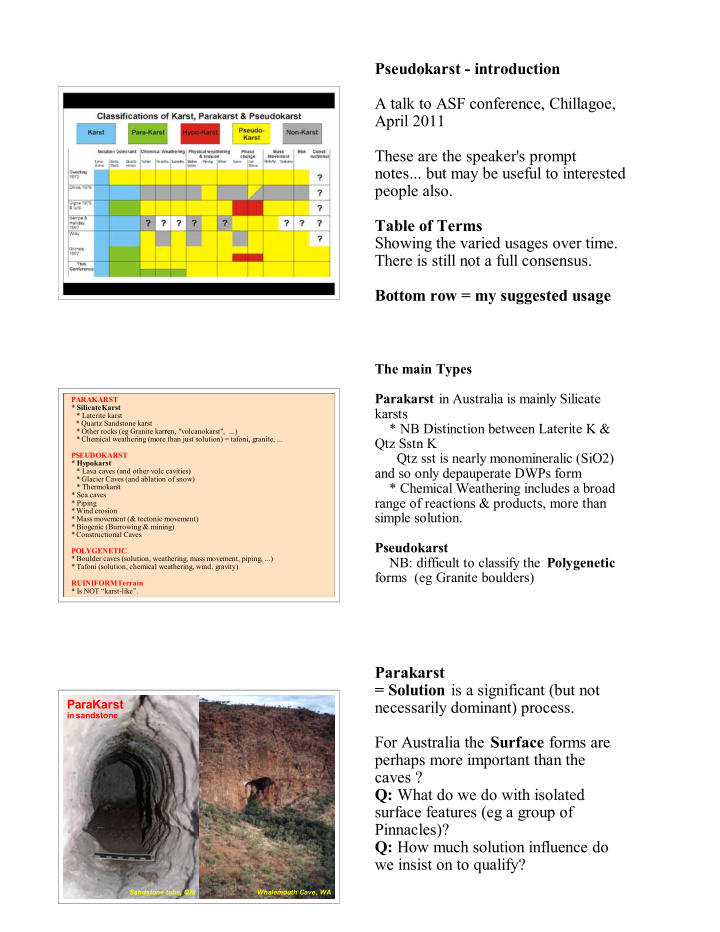



Pseudokarst - introduction A talk to ASF conference, Chillagoe, April 2011 These are the speaker's prompt notes... but may be useful to interested people also. Table of Terms Showing the varied usages over time. There is still not a full consensus. Bottom row = my suggested usage The main Types Parakarst in Australia is mainly Silicate PARAKARST * Silicate Karst karsts * Laterite karst * Quartz Sandstone karst * NB Distinction between Laterite K & * Other rocks (eg Granite karren, "volcanokarst", ...) * Chemical weathering (more than just solution) = tafoni, granite, ... Qtz Sstn K Qtz sst is nearly monomineralic (SiO2) PSEUDOKARST * Hypokarst and so only depauperate DWPs form * Lava caves (and other volc cavities) * Glacier Caves (and ablation of snow) * Chemical Weathering includes a broad * Thermokarst * Sea caves range of reactions & products, more than * Piping * Wind erosion simple solution. * Mass movement (& tectonic movement) * Biogenic (Burrowing & mining) * Constructional Caves Pseudokarst POLYGENETIC * Boulder caves (solution, weathering, mass movement, piping, ...) NB: difficult to classify the Polygenetic * Tafoni (solution, chemical weathering, wind, gravity) forms (eg Granite boulders) RUINIFORM Terrain * Is NOT “karst-like”. Parakarst = Solution is a significant (but not ParaKarst necessarily dominant) process. in sandstone For Australia the Surface forms are perhaps more important than the caves ? Q: What do we do with isolated surface features (eg a group of Pinnacles)? Q: How much solution influence do we insist on to qualify? Sandstone tube, Qld Whalemouth Cave, WA
Laterite karst Deep Weathering profiles (DWP) Laterite Karst = solution + other weathering Doomadgee Plain, Qld processes and removal of soft material. Various features at all scales .... Caves are under the duricrust, and are generally small shelters, but a few complex ones occur. 1 km Lava Tubes =Draining of liquid lava from beneath Lava Tubes a solidified crust A range of sizes and styles Come in all sizes Also other volcanic caves (eg open .... vents) Undara, Qld Mt Eccles, Vic Glacier Caves = Melting of Ice, plus sublimation. Glacier Caves Not in Australia, but Antarctica etc... Canada !
Tafoni: =Weathering behind a case-hardened Tafoni - are usually not “true” caves surface. Almost always small "shelters" but a few "true" caves can occur. Granite Boulder Caves = polygenetic !!! = chem weathering (including Solution), piping and other mechanical removal of soft material. = ALSO mass movement varieties (Talus caves) Granite boulder caves Labertouche, Vic Sea Caves = Wave energy, possibly aided by Sea Caves chemical weathering Most are small Some have associated UG drainage, dolines etc. Tasman Arch, Tas Torres Strait, Qld
Piping Caves = Groundwater carries fine clays etc Piping Caves Mt Gravatt, Qld Also Spring sapping Mostly small tunnels, but some larger ones. May have assoc UG drainage, dolines etc. Mass Movement = Fissures opened up by block sliding Mass Movement etc. Fissure Caves = Also Tectonic movements Pilchers Mtn, NSW = Talus caves are a type of "boulder" cave. BioKarst (?) Animals: digging, eating, ... Biologically formed Caves (Homokarst ?) Humans: Mining, Drains, Military, etc. May produce major subsidence to form sinkholes etc on surface. Old mines can have oddball speleothems. (c) S. Jolly
Constructional Caves = Build up of material encloses a Constructional Caves (Tufa Cave) space to form a cave eg Tufa Caves (behind watefalls or in ponds) Elsey Creek, NT The main diagram again ... for discussion ...
Recommend
More recommend